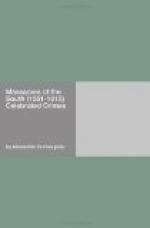The Protestants took what they were offered, but of course like all who accept benefits they went away filled with discontent because they had not been given more.
Although the Protestants ever afterwards looked on Henri IV as a renegade, his reign nevertheless was their golden age, and while it lasted Nines was quiet; for, strange to say, the Protestants took no revenge for St. Bartholomew, contenting themselves with debarring the Catholics from the open exercise of their religion, but leaving them free to use all its rites and ceremonies in private. They even permitted the procession of the Host through the streets in case of illness, provided it took place at night. Of course death would not always wait for darkness, and the Host was sometimes carried to the dying during the day, not without danger to the priest, who, however, never let himself be deterred thereby from the performance of his duty; indeed, it is of the essence of religious devotion to be inflexible; and few soldiers, however brave, have equalled the martyrs in courage.
During this time, taking advantage of the truce to hostilities and the impartial protection meted out to all without distinction by the Constable Damville, the Carmelites and Capuchins, the Jesuits and monks of all orders and colours, began by degrees to return to Nines; without any display, it is true, rather in a surreptitious manner, preferring darkness to daylight; but however this may be, in the course of three or four years they had all regained foothold in the town; only now they were in the position in which the Protestants had been formerly, they were without churches, as their enemies were in possession of all the places of worship. It also happened that a Jesuit high in authority, named Pere Coston, preached with such success that the Protestants, not wishing to be beaten, but desirous of giving word for word, summoned to their aid the Rev. Jeremie Ferrier, of Alais, who at the moment was regarded as the most eloquent preacher they had. Needless to say, Alais was situated in the mountains, that inexhaustible source of Huguenot eloquence. At once the controversial spirit was aroused; it did not as yet amount to war, but still less could it be called peace: people were no longer assassinated, but they were anathematised; the body was safe, but the soul was consigned to damnation: the days as they passed were used by both sides to keep their hand in, in readiness for the moment when the massacres should again begin.




